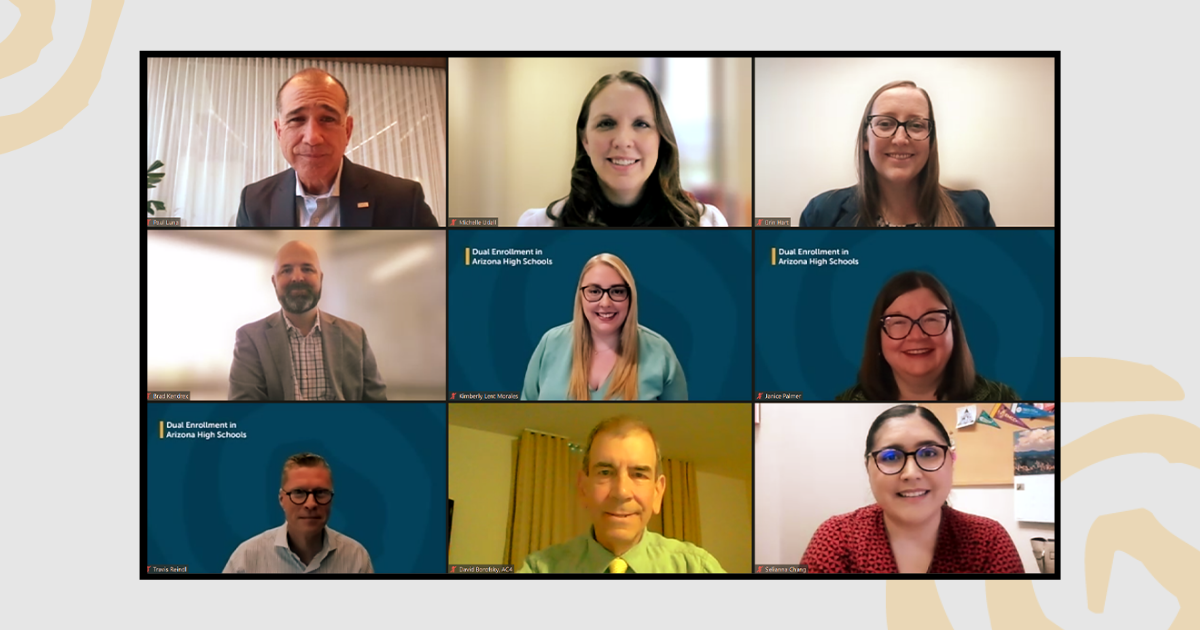Webinar recap: What you need to know about new dual enrollment funding in Arizona

Dual enrollment allows high school students to take college-level courses while they’re still in high school. These courses count for both high school and college credit. Research shows that dual enrollment students are more likely to attend college, have a higher college GPA, and complete a degree.
Helios Education Foundation on July 20 hosted a one-hour webinar to raise awareness about the benefits of dual enrollment to students and new state funding in Arizona meant to help increase access, especially for low-income students who have some of the lowest participation rates.
More than 200 participants joined the webinar, including school counselors, dual enrollment coordinators, college advisors, high school principals and teachers. They heard from several education experts. Here are the major takeaways from the webinar.
New funding approved for dual enrollment in Arizona
This year’s state budget includes $15.5 million to help reduce the cost of dual enrollment courses, which is one of the biggest barriers for students, and to incentives teachers to become certified to teach the courses.
Of the new state funds, $15 million will cover reimbursements of up to $50 per credit hour. There’s a maximum of $300 for freshmen and sophomores and up to $600 for juniors and seniors. Students will need to have a 2.5 GPA or higher and earn a passing grade in the dual enrollment class to qualify. Priority will be given to students from low-income backgrounds, which will be determined through their eligibility for free or reduced lunch.
The rest of the funds will cover bonuses for new dual enrollment teachers. They can qualify for up to $1,000 if they earn dual enrollment certification starting this year and provide instruction in at least one course.
Which dual enrollment courses qualify for this funding?
The dual enrollment courses must be offered by a community college, university or institution that provides a qualifying dual enrollment course. The courses must be taken at the high school or Career and Technical Education District, and they must allow students to earn both high school and college credit.
The courses must also meet one of the following requirements:
- Fulfills a lower division general education credit at a state university or community college.
- Is a career and technical education course that is required for a certificate, credential or license.
Concurrent enrollment courses that students take on college campuses do not qualify for this funding.
How will the new dual enrollment funding be distributed?
When students enroll for the courses through approved providers, they will be asked a series of questions to determine if they’re eligible for the dual enrollment reimbursement, including their GPA and eligibility for free or reduced lunch. Students cannot be asked about their immigration status.
If students meet the requirements, they will be automatically enrolled and credited up to $50 per credit hour (maximum of $300 for freshmen and sophomores, and $600 for juniors and seniors). The Arizona Department of Education will reimburse the providers for the cost after the students complete the course.
What are the requirements to teach dual enrollment in Arizona?
To become certified to teach dual enrollment courses in Arizona, teachers must have a master’s degree in the content area or a master’s degree in any area with 18 graduate-level credit hours in the area they plan to teach.
The Arizona Teachers Academy provides scholarships to support the attainment and maintenance of dual enrollment certification for high school teachers through partnerships with Northern Arizona University and Arizona State University.
What are the benefits of dual enrollment for students?
Helios Education Foundation research shows students who participate in dual enrollment are more than twice as likely to attend college. They’re also more likely to stay enrolled, earn a higher GPA, and complete a degree. This increased likelihood is greatest for students who are male, Latino, low-income, and in special education.
In addition, dual enrollment prepares students and gives them confidence that they’ll be ready for the rigorous coursework they’ll face in college. It also reduces the eventual college tuition cost because students can earn college credits even before they graduate high school.
Is access to dual enrollment equitable in Arizona?
Helios Education Foundation research shows nearly half (47%) of Arizona schools don’t offer dual enrollment courses. And less than a quarter of Arizona students take at least one dual enrollment course in high school. Latino students (17.2%), students from low-income backgrounds (17.1%), and Black students (13%) have some of the lowest participation rates.
Helios will work with stakeholders to ensure the new funding for dual enrollment is effectively implemented so that it reaches more students and more schools across the state.
We thank the speakers who joined the Dual Enrollment in Arizona High Schools webinar:
- Erin Hart, policy advisor for higher education and early education for the Office of Governor Katie Hobbs
- Selianna R. Chang, policy advisor for K-12 education for the Office of Governor Katie Hobbs
- Bradley Kendrex, vice president of finance and administration for the Arizona Board of Regents
- David Borofsky, interim executive director for the Arizona Community College Coordinating Council
- Michelle Udall, associate superintendent of school improvement for the Arizona Department of Education

